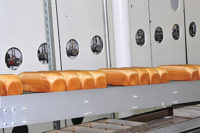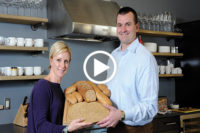One day, Wakefield was without a needed baking ingredient. Having a bar of semi-sweet chocolate on hand, she chopped it and stirred the pieces into the cookie dough. She assumed that the chocolate would melt and spread throughout each cookie. Instead, the bits held their shape and created a sensation. She called the creation Toll House Crunch Cookies, which quickly became very popular with guests. The recipe was published in a Boston newspaper, as well as other papers in New England. It became nationally known later when Betty Crocker used it in her radio series on “Famous Foods From Famous Eating Places.”
1937 was also the year that Krispy Kreme Doughnuts came into being. The company says that Vernon Rudolph bought a secret yeast-raised donut recipe from a New Orleans chef, rented a building in what is now historic Old Salem in Winston-Salem, N.C., and began selling his Original Glazed donuts to local grocery stores in July of that year. As time went on, he owned a small chain of stores and later built a mixing plant and developed a distribution system and his own donut-making equipment. From the 1950s on, the company focused on improving and automating its processes.
Pepperidge Farm founder Margaret Rudkin, who had never baked bread in her life, had to start in the mid 1930s when her youngest son suffered severe allergies and asthma. He was unable to eat most commercially processed foods, so Rudkin decided to try baking him all-natural, stone-ground whole-wheat bread with the vitamins and nutrients intact.
“My first loaf should have been sent to the Smithsonian Institution as a sample of Stone Age bread,” she has been quoted as saying, “for it was hard as a rock and about one inch high.” But she started over and soon achieved a famous loaf of bread, which would head to grocery stores. Rudkin’s tiny Pepperidge Farm company was born. By 1939, Pepperidge Farm had produced 500,000 loaves of bread and the rest, as they say, is history.
Continental Baking, organized by William Ward, a baking giant in the 1920s with United Bakeries, was part of Ward’s plan to acquire as many baking operations, flour mills and other types of food manufacturing units, as possible. Ward next formed General Baking Corp. for the purpose of controlling General Baking, one of the first multi-unit pioneers, with a whopping 33 bakeries. Ward’s grand scheme was to combine Continental and General Baking into a super holding corporation, but the government quickly intervened, brining an anti-trust suit against him, charging him with violating the Sherman Anti-Trust Act and the Clayton Act.
Yet despite such mishandlings, multi-market firms became a fixture in the industry.

















